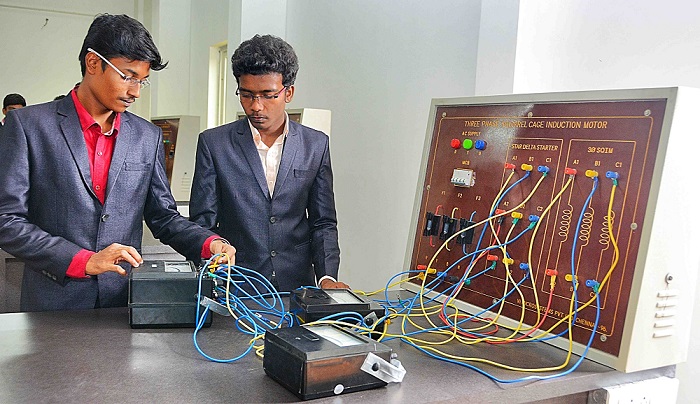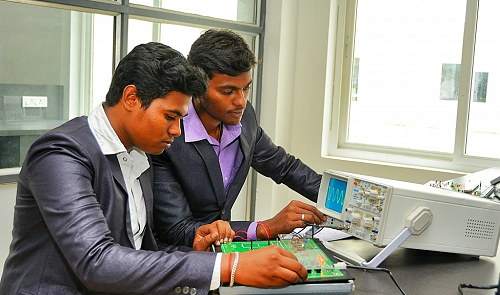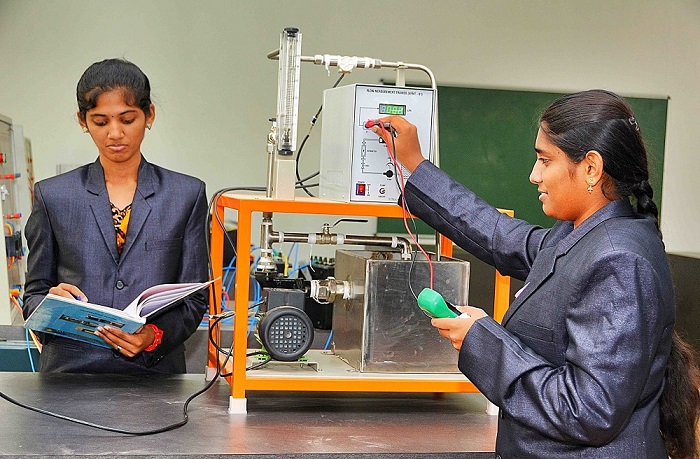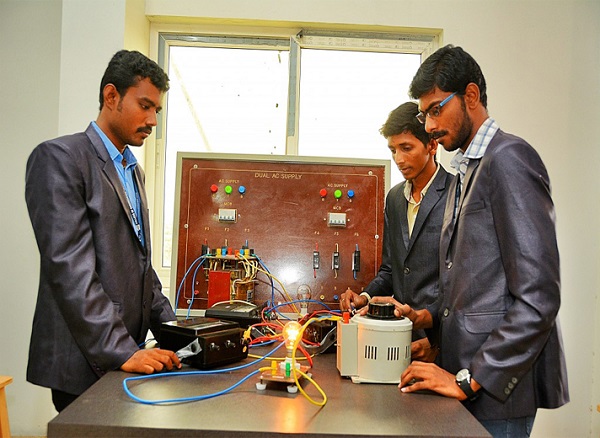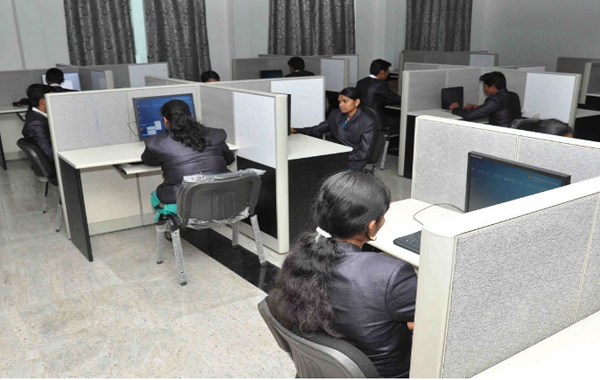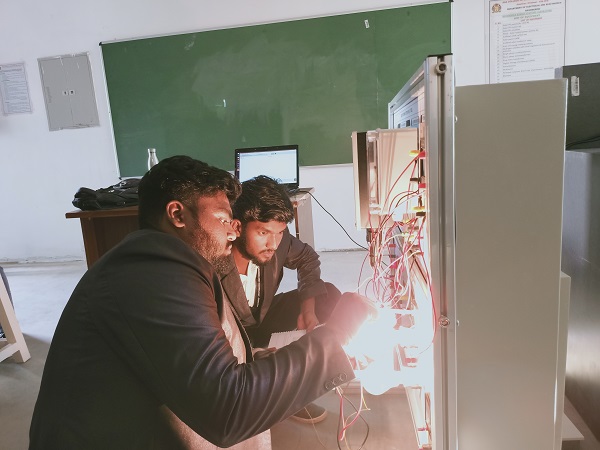Electrical and Electronics Engineering
Our Department is offering B.E.-EEE programme from 2013. We are having well qualified team with experienced faculties with cadre ratio as per AICTE, are guiding the students to attain the best educational objectives. Our department has 7 well equipped laboratories catering the curriculum requirements. Our objective is to provide knowledge and significant design experience across the key areas of electrical engineering that fulfills the needs of the society.
The field of Electrical Engineering is highly dynamic and exciting as it provides excellent career opportunities in all sectors of society. The advancements of electrical engineering make our modern society more comfort in all areas including health, business, education and entertainment. Electrical Engineers design and implement a wide range of systems such as power generation, transmission and distribution, telecommunication networks, electrical machines and modern industrial control systems.
Vision
- To be an eminent department by imparting professional knowledge and a sense of ethics through quality teaching, training and collaborative research.
Mission
- To enlight students with sound technical knowledge and practical skills in electrical engineering through modern pedagogy delivered by eminent faculties with state of the art facilities.
- To educate students to be responsible electrical engineering professionals and entrepreneurs with moral values and ethics for serving the needs of the society.
- To evolve technological innovations that address the modern needs of electrical engineering through appropriate training and collaborative research.
Program Specific Outcomes (PSOs)
- Ability to apply the fundamental knowledge to identify and solve electrical engineering problems in electrical drives, embedded systems, power systems and control engineering.
- Ability to apply the acquired engineering knowledge for the planning, analysis, design and implementation of hardware systems with due consideration of electrical safety and eco-friendliness.
- Ability to demonstrate technical competency and provide cost- effective solution for real life/societal problems through the knowledge acquired in science and engineering, leading to a successful career in industry/ research.
Program Educational Objectives (PEOs)
- Excel in career as an eminent electrical engineering professional.
- Effectively utilize their technical and managerial skills for the solution of electrical engineering problems.
- Engage in professional activities, commit to team work and continuously update themselves to adapt changing global technological environment.
|
Course Code & Name |
Course Outcome No. |
Course Outcomes |
|
SEMESTER – I |
||
|
After completion of the course, the students will be able to |
||
|
HS8151 & Communicative English |
1 |
Build listening skills to acknowledge formal and informal conversations |
|
2 |
Illustrate the various kinds of Grammar in speaking etiquette |
|
|
3 |
Describe the narrative techniques in Communication |
|
|
4 |
Interpret writings and formulate simple sentences in English |
|
|
5 |
Classify the main and sub-ordinate ideas in writing |
|
|
MA8151 & Engineering Mathematics – I |
1 |
Apply limits and differentiation to differentiate functions and solve maxima and minima problems. |
|
2 |
Evaluate integrals using Riemann sums and Fundamental Theorem of Calculus. |
|
|
3 |
Apply integration to compute multiple integrals, area, volume, integrals in polar coordinates, in addition to change of order and change of variables |
|
|
4 |
Evaluate integrals by using techniques of integration, such as substitution, partial fractions and integration by parts |
|
|
5 |
Determine convergence/divergence of improper integrals and evaluate convergent improper integrals. Apply various techniques in solving differential equations |
|
|
PH8151 & Engineering Physics |
1 |
Describe the fundamentals of properties of matter to formulate and analyze the problems in columns and beams. |
|
2 |
Summarize the concepts and applications of waves, lasers and fiber optics to give theoretical approaches to design modern devices. |
|
|
3 |
Identify the thermal properties of materials required for expansion joints and heat exchangers and determine the heat flow. |
|
|
4 |
Explain the concepts of advanced quantum theory and its applications in tunneling microscopes for both the mathematical and physical prediction. |
|
|
5 |
Explain the basics of crystals, their structures and different crystal growth techniques to understand the behavior of the solids. |
|
|
CY8151 & Engineering Chemistry |
1 |
Illustrate the methods of water softening, requirements of boiler feed water and water treatment methods. |
|
2 |
Explain catalysis theories and adsorption concepts used in pollution abatement. |
|
|
3 |
Identify the eutectic mixtures of suitable alloys for the replacement of traditional materials in Engineering applications. |
|
|
4 |
Describe methods of fuel manufacture and calculation of calorific value to meet desired needs within realistic constraints. |
|
|
5 |
Explain the principle and generation of energy in batteries, nuclear reactors, solar cells, wind mills and fuel cells to give an idea about various energy sources and storage devices. |
|
|
GE8151 & Problem Solving and Python Programming |
1 |
Develop algorithmic solutions to simple computational problems |
|
2 |
Read, write, and execute simple Python programs. |
|
|
3 |
Develop simple Python programs for solving problems and decompose them into functions |
|
|
4 |
Represent compound data using Python lists, tuples, dictionaries |
|
|
5 |
Describe the methods to read and write data from/to files in python programs |
|
|
GE8152 & Engineering Graphics |
1 |
Perform freehand sketching of basic geometrical constructions and multiple views of objects and conic sections. |
|
2 |
Develop orthographic projections of lines and plane surfaces |
|
|
3 |
Draw projections of solids |
|
|
4 |
Draw projections of sectional views and development of surfaces |
|
|
5 |
Visualize and project isometric and perspective sections of simple solids |
|
|
GE8161 & Problem Solving and Python Programming Laboratory |
1 |
Solve simple computational problems using python programs |
|
2 |
Solve problems using conditions & loops in python |
|
|
3 |
Develop Python programs by defining functions and calling them |
|
|
4 |
Apply python list, tuples and dictionaries for representing compound data |
|
|
5 |
Develop python programs using files |
|
|
BS8161 & Physics and Chemistry Laboratory |
1 |
Demonstrate the basic concepts like torque, elasticity and bending moment of beams for various engineering applications by the determination of rigidity modulus of the wire and young’s modulus of the material of the beam by non-uniform bending. |
|
2 |
Identify the fundamentals of thermal properties of material of the bad conductor by Lee’s disc method. |
|
|
3 |
Demonstrate the estimation of DO content in water sample by Winkler’s method and molecular weight of polymer by Ostwald viscometer |
|
|
4 |
Determine the strength of an acid using pH meter and conductometer |
|
|
5 |
Demonstrate the estimation of weak and strong acids in a mixture by conductometer |
|
|
SEMESTER – II |
||
|
HS8251 & Technical English |
1 |
Develop the listening skill to comprehend lectures and talk in their area of specialization successfully. |
|
2 |
Improve the speaking ability to communicate effectively in varied formal and informal contexts. |
|
|
3 |
Build the reading proficiency for effective understanding of scientific and technical reports. |
|
|
4 |
Construct sentences successfully for effective writing of journal papers and job winning applications. |
|
|
5 |
Enhance communication skills for competent reporting and presenting among the engineering community. |
|
|
MA8251 & Engineering Mathematics – II |
1 |
Apply the idea of reducing complex problems into simple form using matrix technique. |
|
2 |
Apply line, surface and volume integrals using Gauss, Stokes and Green’s theorems and verify |
|
|
3 |
Apply Analytic functions, conformal mapping and complex integration to simplify complex problems |
|
|
4 |
Apply various techniques in solving complex integration problem to simple problem by using residue technique |
|
|
5 |
Apply Laplace transform and inverse Laplace transform to solve differential equations with constant coefficients |
|
|
PH8253 & Physics for Electronics Engineering |
1 |
Describe the classical and quantum electron theories and energy band structures to analyze the materials for their specific applications. |
|
2 |
Explain the fundamentals of semiconductor physics used in semiconductor electronic devices such as hall devices, ohmic contacts, schottky diode and power transistor. |
|
|
3 |
Summarize the properties of magnetic and dielectric materials used in modern devices such as Magnetic hard disc, sensor and computer data storage. |
|
|
4 |
Identify the properties of optical materials in optoelectronics to describe the theoretical approaches for the design of optoelectronic devices. |
|
|
5 |
Describe the basics of quantum structures and manipulation of materials at nanometer scale in spintronics and carbon electronics. |
|
|
BE8252 &Basic Civil and Mechanical Engineering |
1 |
Summarize the scope of Civil and Mechanical engineering |
|
2 |
Describe the types of construction materials and principles of surveying |
|
|
3 |
Explain the types of civil engineering structures and basic principles of highway & railway engineering |
|
|
4 |
Demonstrate working principles of petrol, diesel engine and identify the components used in power plant cycle. |
|
|
5 |
Elaborate the components of refrigeration and Air conditioning cycle |
|
|
GE8291 & Environmental Science and Engineering |
1 |
Explain the values, threats and conservation of biodiversity and classify various Ecosystems. |
|
2 |
Identify and implement technological and economical solution to environmental pollution. |
|
|
3 |
Develop the knowledge on various natural resources, their causes and their effects. |
|
|
4 |
Illustrate the methods of disaster management and specify the legal responsibilities of an individual. |
|
|
5 |
Describe the need of awareness about population growth, family welfare, value education and role of IT in environment and human health. |
|
|
EE8251 & Circuit Theory |
1 |
Solve basic electric circuits using mesh and nodal analysis. |
|
2 |
Apply network reduction techniques to solve the given DC or AC circuits. |
|
|
3 |
Analyze the transient response of RL, RC & RLC circuits using Laplace Transform technique for AC and DC inputs. |
|
|
4 |
Determine various electrical parameters in three-phase AC circuits under balanced/unbalanced conditions. |
|
|
5 |
Determine frequency response characteristics of resonance circuits and its associated parameters and to explain the operation of single tuned circuits. |
|
|
GE8261 & Engineering Practices Laboratory |
1 |
Develop pipe connections with mixed material, joining components and prepare plumbing line sketches for water treatment, sewage works and highrise buildings |
|
2 |
Develop models and joints using sheet metal, carpentry and fitting works |
|
|
3 |
Illustrate the use of arc and gas welding to prepare joints and demonstrate basic machining, smithy and foundry operations |
|
|
4 |
Demonstrate the basic home electrical wiring work and measure the electrical quantities such as energy, current, voltage, power, power factor and resistance to earth |
|
|
5 |
Demonstrate the applications of electronics components, gates using simple circuits |
|
|
EE8261& Electric Circuits Laboratory |
1 |
Analyse the electrical circuits using Kirchoff’s law, mesh analysis and nodal analysis. |
|
2 |
Applying suitable theorems to reduce the given complex circuit to simple circuit. |
|
|
3 |
Analyze transient response of RL, RC and RLC circuits. |
|
|
4 |
Simulate different forms of three phase circuits. |
|
|
SEMESTER – III |
||
|
MA8353 & Transforms and Partial differential Equations
|
1 |
Solve differential equations in vibration analysis and signal processing by using Fourier series. |
|
2 |
Apply Fourier series techniques to solve one- and two-dimensional heat flow problems andalso one-dimensional wave equations. |
|
|
3 |
Apply the mathematical principles on transforms and partial differential equations to formulate and solve physical problems in engineering. |
|
|
4 |
Apply Z transform techniques to solve Partial Differential equations and discrete time systems |
|
|
5 |
Apply partial differential equation concepts in solving homogeneous and non- homogeneous equations. |
|
|
EE8351 & Digital Logic Circuits |
1 |
Apply the concepts of Number systems and Boolean functions to simplify the logical expressions. |
|
2 |
Design combinational Circuits using Karnaugh Map. |
|
|
3 |
Design Synchronous sequential circuits using Flip – Flops. |
|
|
4 |
Design asynchronous sequential circuits and PLDs. |
|
|
5 |
Describe digital simulation for development of application oriented logic circuits. |
|
|
EE8301 & Electrical Machines I |
1 |
Implement abstract data types for linear data structures. |
|
2 |
Apply the different linear data structures to solve problems. |
|
|
3 |
Examine the Non-Linear data structure – Tree. |
|
|
4 |
Discuss the concept of Graph and its applications. |
|
|
5 |
Analyze the performance of various Sorting algorithms and Hashing Techniques. |
|
|
EC8353 & Electron Devices and Circuits |
1 |
Explain the structure and working operation of basic electronic devices. |
|
2 |
Classify the active and passive elements. |
|
|
3 |
Infer the characteristics of different electronic devices such as diodes and transistors. |
|
|
4 |
Identify the required components to construct an amplifier circuit. |
|
|
5 |
Explain the concepts in design and analysis of oscillators |
|
|
EE8391 &Electromagnetic Theory |
1 |
Apply vector calculus to static electric-magnetic field problems in different engineering situations. |
|
2 |
Solve electric potential problems in linear, isotropic media for simple geometrics. |
|
|
3 |
Determine voltage gradients for simple charge and current configurations and the force between charges and currents. |
|
|
4 |
Analyze Maxwell’s equation in different forms (differential and integral) and apply them to diverse engineering problems. |
|
|
5 |
Examine the phenomena of wave propagation in free space and different media and its interfaces |
|
|
ME8792 & Power Plant Engineering |
1 |
Explain the layout, construction and working of the components of a thermal power plant. |
|
2 |
Explain the layout, construction and working of the components of a Diesel, Gas and Combined cycle power plants. |
|
|
3 |
Explain the layout, construction and working of the components of nuclear power plants. |
|
|
4 |
Explain the layout, construction and working of the components of Renewable energy power plants. |
|
|
5 |
Describe energy, economic and environmental issuses of Power Plants. |
|
|
EC8311& Electronics Laboratory |
1 |
Explain the fundamentals of operation and characteristics of semiconductor devices. |
|
2 |
Calculate the basic parameters of semiconductor devices and their limiting factors |
|
|
3 |
Demonstrate BJT amplifiers in various configurations including DC biasing techniques. |
|
|
4 |
Determine the frequency response characteristics of amplifiers. |
|
|
5 |
Construct basic electronic circuits, particularly with application to diodes, field effect transistors and bipolar junction transistors. |
|
|
EE8311 & Electrical Machines Laboratory – I |
1 |
Determine the performance of various D.C. Generators and understand the applications of it to power system |
|
2 |
Draw the performance characteristics of various D.C. Motors and understand the applications of it to power system |
|
|
3 |
Predetermine the performance of DC motor by conducting suitable tests |
|
|
4 |
Calculate the voltage regulation and predetermine the performance of the single phase and three phase transformer |
|
|
SEMESTER – IV |
||
|
MA8491 &Numerical Methods |
1 |
Apply algebraic and transcendental equations using iteation methods and Newton-Raphson methods |
|
2 |
Apply the numerical techniques of interpolation and error approximations in Newton divided difference problems |
|
|
3 |
Apply the numerical techniques of differentiation and integration for engineering problems. |
|
|
4 |
Identify the proper technique to solve first and second Order ordinary differential equations problems. |
|
|
5 |
Solve the partial and ordinary differential equations with initial and boundary conditions by using certain techniques with engineering applications. |
|
|
EE8401 &Electrical Machines – II |
1 |
Analyse the performance of salient and non – salient type synchronous generator using emf, mmf and ASA method. |
|
2 |
Determine the performance characteristics of synchronous motor by V and inverted V- curve. |
|
|
3 |
Describe the construction and working of induction motor and analyse the performance using circle diagram. |
|
|
4 |
Explore the different types of starting, speed control and braking of three phase induction motors. |
|
|
5 |
Describe the construction, principle of operation and performance characteristics of single-phase induction motors and special machines. |
|
|
EE8402 &Transmission And Distribution |
1 |
Explain the structure of power system and the operation of various types of power plants. |
|
2 |
Determine the transmission line parameters of single and double circuit. |
|
|
3 |
Explain the different types of insulators, cables and different distribution schemes. |
|
|
4 |
Suggest methods to improve voltage distribution in insulator strings and cables. |
|
|
5 |
Compare the different types of distribution system. |
|
|
EE8403 &Measurements And Instrumentation |
1 |
Identify the various functional blocks of an instrument and select appropriate instruments for voltage and current measurement |
|
2 |
Select suitable type of instrument to measure electric and magnetic parameters |
|
|
3 |
Classify and differentiate the types of potentiometers & bridges |
|
|
4 |
Select the appropriate storage and display devices for a system |
|
|
5 |
Apply the knowledge of transducers, DAS in the field of Industrial Automation. |
|
|
EE8451 & Linear Integrated Circuits and Applications |
1 |
Describe the fabrication procedure in IC. |
|
2 |
Analyze the characteristics of Op-Amp. |
|
|
3 |
Summarize the importance of Signal analysis using Op-amp based circuits. Functional blocks and the applications of special ICs like Timers, PLL circuits, regulator Circuits. |
|
|
4 |
Illustrate the Arithmetic and logical applications using Op-amp. |
|
|
5 |
Describe the features of Application ICs. |
|
|
IC8451& Control Systems |
1 |
Develop representation and transfer functions of mechanical and electro mechanical systems. |
|
2 |
Analyze time domain of various models of linear system. |
|
|
3 |
Analyze frequency domain of various models of linear system. |
|
|
4 |
Design appropriate compensator for the given specifications. |
|
|
5 |
Apply state variable analysis techniques to solve complex control problems. |
|
|
EE8411 & Electrical Machines Laboratory – II
|
1 |
Determine the voltage regulation of three phase alternator in different methods and compare the results. |
|
2 |
Draw the performance characteristics of synchronous motor |
|
|
3 |
Determine and pre determine performance characteristics of three phase induction motor |
|
|
4 |
Calculate the efficiency and performance characteristics of single phase induction motor |
|
|
EE8461 & Linear and Digital Integrated Circuits Laboratory |
1 |
Implementation of Boolean Functions and Design Adder, Subtractor, code converter, Parity generator and checker. |
|
2 |
Design Encoder, decoder, Multiplexer and Demultiplexer. |
|
|
3 |
Design and implement 4-bit shift registers. |
|
|
4 |
Design basic OP-AMP application circuits and Variable Voltage Regulator using IC LM317. |
|
|
5 |
Construct Timers and counters using specific IC. |
|
|
EE8412 & Technical Seminar |
1 |
Present seminar in the field of electrical and electronics engineering subjects studied. |
|
2 |
Solve objective type questions in the field of electrical and electronics engineering. |
|
|
3 |
Present a topic of recent advancement infront of peers and faculty members |
|
|
4 |
Perform well in placement recruitment drive with good technical skills and communication skills |
|
|
SEMESTER – V |
||
|
EE8501 & Power System Analysis |
1 |
Explain the operation of various power system Components and determine ‘per unit’ diagram and bus admittance matrix. |
|
2 |
Develop the power flow equation for power system components to find line flows using various algorithms. |
|
|
3 |
Calculate the fault currents in a network using symmetrical fault analysis. |
|
|
4 |
Analyze a sequence network of a power system for L-G, L-L and L-L-G faults and Determine their fault currents. |
|
|
5 |
Analyze the transients and stability in single machine infinite bus system |
|
|
EE8551 & Microprocessors and Microcontrollers |
1 |
Explain the architecture and functionalities of 8085 Microprocessor. |
|
2 |
Develop Assembly level programming in real time applications using 8085. |
|
|
3 |
Explain the architecture and functionalities of 8051 Microcontroller. |
|
|
4 |
Configure the external peripherals interfacing with the 8085 microprocessor and 8051 microcontroller. |
|
|
5 |
Develop simple applications programs with 8085 and 8051. |
|
|
EE8552 & Power Electronics |
1 |
Explain the basics of power semiconductor devices and their switching. |
|
2 |
Analyze the performance parameters of single and three phase converters. |
|
|
3 |
Describe the basic topologies, operation and switching techniques of DC to DC converters. |
|
|
4 |
Analyze the operation of single phase and three phase Inverters with and without PWM techniques |
|
|
5 |
Illustrate the operation of various types of AC to AC converters. |
|
|
EE8591 & Digital Signal Processing |
1 |
Identify the different types of signals and systems and their representation in continous time and Discrete time. |
|
2 |
Apply Z-Transform and DTFT in discrete time systems |
|
|
3 |
Apply Radix-2 DIT and DIF FFT Algorithm to Compute Discrete Fourier Transform. |
|
|
4 |
Design the Infinite Impulse Response (IIR) filters and Finite Impulse Response (FIR) filters. |
|
|
5 |
Explain various architectures and its functionalities of Digital signal processors |
|
|
CS8392 & Object Oriented Programming |
1 |
Develop Java programs using OOP principles. |
|
2 |
Develop Java programs with the concepts inheritance and interfaces. |
|
|
3 |
Build Java applications using exceptions and I/O streams. |
|
|
4 |
Develop Java applications with threads and generics classes. |
|
|
5 |
Develop interactive Java programs using swings. |
|
|
OAN551 & Sensors and Transducers |
1 |
Describe various calibration techniques and signal types for sensors. |
|
2 |
Apply the motion, proximity and ranging sensors in the Automotive and Mechatronics applications. |
|
|
3 |
Apply the force, magnetic and heading sensors in the Automotive and Mechatronics applications. |
|
|
4 |
Explain the basic principles of the optical, pressure and temperature sensors and various smart sensors. |
|
|
5 |
Implement the DAQ systems with different sensors for real time applications. |
|
|
EE8511& Control and Instrumentation Laboratory |
1 |
Explain control theory and apply them to electrical engineering problems. |
|
2 |
Analyze the various types of ADC, DAC converters. |
|
|
3 |
Design lag, lead and lag-lead compensators. |
|
|
4 |
Describe the basics of bridge networks and signal conditioning circuits. |
|
|
5 |
Demonstrate the response and stability of control systems using simulation package.
|
|
|
HS8581 & Professional Communication |
1 |
Make effective presentations. |
|
2 |
Participate confidently in Group Discussions. |
|
|
3 |
Attend job interviews and be successful in them. |
|
|
4 |
Develop adequate Soft Skills required for the workplace |
|
|
CS8383 & Object Oriented Programming Laboratory |
1 |
Develop Java programs using OOP principles. |
|
2 |
Develop Java programs with the concepts inheritance and interfaces. |
|
|
3 |
Build Java applications using exceptions and I/O streams. |
|
|
SEMESTER – VI |
||
|
EE8601& Solid State Drives |
1 |
Explain the steady state operation and transient dynamics of a motor load system. |
|
2 |
Examine the operation of the converter/chopper fed dc drive |
|
|
3 |
Apply the control methods for the induction motor drives for suitable applications. |
|
|
4 |
Analyze the operation and performance of synchronous motor drives. |
|
|
5 |
Design the current and speed controllers for a closed loop solid state DC motor drives. |
|
|
EE8602 & Protection and Switchgear |
1 |
Describe the causes of abnormal operating conditions and the protection schemes equipped for it. |
|
2 |
Analyze the characteristics and functions of different types of electromagnetic relays. |
|
|
3 |
Explain the concepts of protection of apparatus used in power system. |
|
|
4 |
Illustrate the concepts of numerical protection and characteristics of static relays. |
|
|
5 |
Explain the construction and working of different types of circuit breakers. |
|
|
EE8691 & Embedded Systems |
1 |
Explain the building blocks of Embedded systems. |
|
2 |
Describe about the Communication in Embedded systems. |
|
|
3 |
Describe the various processor scheduling algorithms. |
|
|
4 |
Discuss the concepts of Real time operating system. |
|
|
5 |
Suggest an embedded system for a given application |
|
|
EE8002 & Design of Electrical Apparatus |
1 |
Determine heat dissipation of electrical engineering materials due to Conduction, Convection and radiation. |
|
2 |
Calculate mmf for slots and teeths, apparent flux density, main dimensions and winding details of DC machines. |
|
|
3 |
Design core, yoke, winding and cooling system of transformers. |
|
|
4 |
Develop output equation of AC machines, design stator and rotor of induction machines. |
|
|
5 |
Design stator and rotor of synchronous machines analyze their thermal behavior, design field systems for turbo alternators. |
|
|
EE8005 & Special Electrical Machines |
1 |
Explain the construction, operation and control methods of stepping motors. |
|
2 |
Describe the operation of various power controllers for switched reluctance motors. |
|
|
3 |
Derive the expressions for magnetic circuit analysis, emf and torque equations of permanent magnet brushless DC motors. |
|
|
4 |
Develop the expression for emf and torque of permanent magnet synchronous motors and choose power controller for permanent magnet synchronous motors. |
|
|
5 |
Illustrate the operation of other special machines and its applications. |
|
|
EE8661 Power Electronics and Drives Laboratory |
1 |
Demonstrate the gate pulse generation using various configurations |
|
2 |
Draw the characteristics of various switches. |
|
|
3 |
Illustrate the operation and performance parameters of DC – AC, DC – DC converter circuits. |
|
|
4 |
Interpret the performance of AC – DC, AC – AC converter circuits. |
|
|
5 |
Simulate various power electronic converter circuits. |
|
|
EE8681 & Microprocessors and Microcontrollers Laboratory |
1 |
Apply the arithmetic operations, logic operations and sorting using 8085 microprocessor. |
|
2 |
Create Programming logics for code conversion. |
|
|
3 |
Analyze the operations of peripheral interfacing with 8085 microprocessor.
|
|
|
EE8611 & Mini Project |
1 |
Apply the fundamental knowledge and skills, which are acquired in the course to a specific problem. |
|
2 |
Apply appropriate techniques and modern engineering hardware and software tools in electrical and electronics engineering and allied applications. |
|
|
3 |
Function effectively as an individual and as a member or leader in diverse teams in multidisciplinary settings and make effective presentation, and communicate effectively. |
|
|
4 |
Document and present one’s own work for a given target group with good oral and written presentation skills and also recognize the need for life-long learning by undergoing the project work |
|
|
SEMESTER – VII |
||
|
EE8701 & High Voltage Engineering |
1 |
Explain the causes of over voltages in power systems. |
|
2 |
Infer the concepts of dielectric breakdown. |
|
|
3 |
Explain the methods of generation of high voltage and currents. |
|
|
4 |
Compare the different methods of measurements of high voltage and high currents. |
|
|
5 |
Explain about insulation coordination and high voltage testing. |
|
|
EE8702 & Power System Operation and Control |
1 |
Describe the day-to-day operation of electric power system. |
|
2 |
Analyze the control actions to be implemented on the system to meet the minute-to-minute variation of system demand. |
|
|
3 |
Explain the significance of power system operation and control. |
|
|
4 |
Compute the real power-frequency and Reactive power – voltage interaction. |
|
|
5 |
Explain the concept of SCADA and its application for real time operation. |
|
|
EE8703 & Renewable Energy Systems |
1 |
Explain the importance and limitations of renewable energies in present Indian and International energy scenario. |
|
2 |
Describe the working of different types of wind power plants and its grid integration issues. |
|
|
3 |
Discuss the solar energy harnessing methods along with types, characteristics and applications. |
|
|
4 |
Analyze the energy conversion process and the environmental effects on biomass energy, geo thermal energy and hydro power generating power plants. |
|
|
5 |
Examine the working of several renewable energy systems such as tidal energy, ocean thermal energy, hydrogen production and storage, Energy storage systems and hybrid systems. |
|
|
EI8075 & Fiber Optics and Laser Instrumentation |
1 |
Explain the principle, transmission, dispersion and attenuation characteristics of opticalfibers. |
|
2 |
Identify Fiber optic sensors for measurement of various parameters in Industries. |
|
|
3 |
Describe laser theory and laser generation system. |
|
|
4 |
Apply laser theory for the selection of lasers for a specific Industrial applications. |
|
|
5 |
Explain the principle of Holography and usage of various lasers in medical applications. |
|
|
EE8010 & Power Systems Transients |
1 |
Analyze the basic transforms of RL & RLC circuit transients. |
|
2 |
Analyze various types of switching transients. |
|
|
3 |
Analyze the mechanism of lightning strokes. |
|
|
4 |
Summarize the importance of propagation, reflection, refraction of travelling waves. |
|
|
5 |
Analyze the voltage transients caused by fault. |
|
|
OML751 & Testing of Materials |
1 |
Explain the purpose of testing & various testing standards. |
|
2 |
Use the different Mechanical Testing Techniques to study the mechanical properties of materials. |
|
|
3 |
Identify suitable nondestructive testing technique to inspect industrial component |
|
|
4 |
Identify suitable Material Characterization Testing to inspect industrial component |
|
|
5 |
Use the different technique and know its applications and limitations. |
|
|
EE8711& Power System Simulation Laboratory
|
1 |
Determine the bus impedance and admittance matrices using MATLAB. |
|
2 |
Solve the power flow problems using GS and NR methods. |
|
|
3 |
Detect Symmetric and Unsymmetrical fault. |
|
|
4 |
Describe the unit commitment and Economic dispatch. |
|
|
5 |
Design the electromagnetic transient circuits. |
|
|
EE8712 & Renewable Energy Systems Laboratory |
1 |
Demonstrate the concept of electric power generation using several renewable energy resources. |
|
2 |
Analyze the characteristics and shadowing effect of solar PV energy system. |
|
|
3 |
Simulate the various Renewable energy sources. |
|
|
4 |
Evaluate the performance of Grid connected and Standalone PV system, micro wind generation, fuel cell and Hybrid systems. |
|
|
5 |
Explain the intelligent controllers for hybrid energy generation systems. |
|
|
SEMESTER – VIII |
||
|
GE8076& Professional Ethics in Engineering |
1 |
Illustrate the principles of human values |
|
2 |
Demonstrate the techniques and theories of Engineering Ethics |
|
|
3 |
Explain the procedure for Engineering as Social Experimentation |
|
|
4 |
Summarize the concept of Safety, Responsibilities and Rights |
|
|
5 |
Explain the different Global Issues |
|
|
EE8019 Smart Grid |
1 |
Explain the concept of smart grid with its challenges and benefits. |
|
2 |
Describe different smart grid technologies in transmission and distribution systems. |
|
|
3 |
Summarize different smart meters and advanced metering infrastructure. |
|
|
4 |
Illustrate the issue in Power Quality Managements in Smart grid. |
|
|
5 |
Describe high performance computing methodsfor Smart Grid applications.
|
|
|
EE8811 & Project Work |
1 |
Identify the problem. |
|
2 |
Analyze problem in various domains and formulate methodology. |
|
|
3 |
Design different solutions for the problem and select the optimum solution. |
|
|
4 |
Develop the project using efficient tools. |
|
|
5 |
Conclude using proper evidence to support them. |
|
To effectuate the demands of the industry, we impart practical training to our students through Value Added Courses in their course fields.
P-Spice
The P-Spice course is conducted for the benefit of the student community in order to improve their knowledge & skill in creating virtual prototypes of various electrical & electronics circuit. By this approach students can find a better way to maximize the circuit performance.
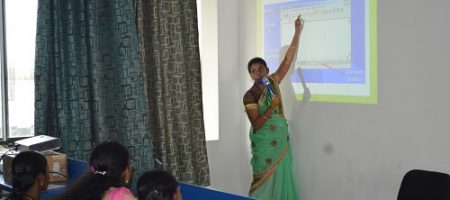
MATLAB
The MATLAB programming practice is provided through this course, where the students are simulating the various control system elements, stability analysis and characteristics of power converter circuits. The course is improving the student’s design skill and problem solving techniques.
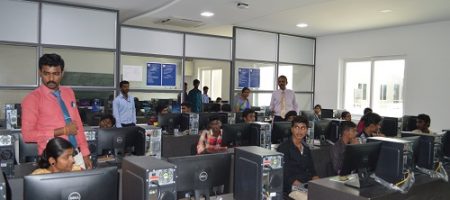
LabView
Nowadays, the main requirements of the industries are programming skills and knowledge on simulation platform like LabView. This course is conducted for the purpose of increasing the employability of the students as per the industrial needs.
Power World Simulator
The power system studies like power flow analysis, stability analysis and power quality enhancements are playing vital role in power station sectors. In order to improve the skills in those areas, this course is conducted for all EEE department students.
Internet of Things
Internet is holding the whole automation world today. So without the studies related to internet of things, no one can survive. This course is targeted for the purpose of sowing the concept of IoT among the student, this course providing Arduino & Node MCU based IoT projects to the students.
E – CAD
The skills on Computer Aided Drawing is one (p)art in the field of Electrical and Electronics Engineering. The drawing of 2D diagrams such circuit diagrams, line diagrams and also 3D machine diagrams are welcomed by the industries. In order to harvest these drawing skills from the students, this course is conducted with the help of Audodesk software.

All department of AAA College of Engineering & Technology organizes several programs in association with professional chapters, Industries, Academicians and Government agencies on a regular basis. The participating students and faculty enhances their knowledge and understanding of the various technological advancements brought to them in the campus through experts. For more details click the below link
EEE Activities
The Department of electrical and Electronics Engineering has well equipped laboratories which help in better understanding of theoretical concepts and exposure of students to practical problems.
The department has the following fully furnished laboratories:
- Electrical Machines Laboratory
- Linear Integrated Circuits Laboratory
- Control and Instrumentation Laboratory
- Power Electronics Laboratory
- Power System Simulation Laboratory
- Renewable Energy Systems Laboratory
- Engineering Practices Laboratory
FACULTY NAME LIST ACADEMIC YEAR 2022 – 2023
|
S.No |
Name |
PAN No |
Qualification |
Area of Specialization |
Designation |
Date of Joining |
Date on which (Designated as Professor/Associate Professor) |
Currently Associated (Y/N) |
Nature of Association (Regular / Contract/Adjunct) |
If contractual mention Full time or Part time |
Date of Leaving (In case Currently Associated is (“No”) |
|
1 |
Dr.C.Senthil Kumar |
BSRPS8869K |
ME/M.Tech and Ph.D |
Power Electronics & Drives |
Professor |
01/06/2015 |
01/06/2015 |
Y |
Regular |
– |
– |
|
2 |
Dr.M.Ramuvel |
BCSPR9495K |
ME/M.Tech and Ph.D |
Power Electronics & Drives |
Associate Professor |
16/08/2021 |
16/08/2021 |
Y |
Regular |
– |
– |
|
3 |
Mr.C.Karuppasamy |
ETBPK4636Q |
M.E/ M.Tech |
Power Electronics & Drives |
Assistant Professor |
22/06/2015 |
– |
Y |
Regular |
– |
– |
|
4 |
Mrs.B.Sarojini |
CPTPS4839B |
M.E/ M.Tech |
Embedded System Technologies |
Assistant Professor |
01/06/2016 |
– |
Y |
Regular |
– |
– |
|
5 |
Mr.M.S.Kalyana Sundaram |
CDYPK4434R |
M.E/ M.Tech |
Applied Electronics |
Assistant Professor |
01/06/2017 |
– |
Y |
Regular |
– |
– |
|
6 |
Mrs.M.Maheswari |
CJLPM2481H |
M.E/ M.Tech |
Power Electronics & Drives |
Assistant Professor |
24/06/2019 |
– |
Y |
Regular |
– |
– |
|
7 |
Mrs.R.Saranya |
GFCPS0618D |
M.E/ M.Tech |
Power Electronics & Drives |
Assistant Professor |
16/08/2021 |
– |
Y |
Regular |
– |
– |
|
8 |
Mr.R.Vinothkumar |
AVIPV4118K |
M.E/ M.Tech |
High Voltage Engineering |
Assistant Professor |
21/02/2022 |
– |
Y |
Regular |
– |
– |
|
9 |
Mrs.V.Chandra |
AVMPC1367M |
M.E/ M.Tech |
Applied Electronics |
Assistant Professor |
01/08/2022 |
– |
Y |
Regular |
– |
– |
|
10 |
Mr.P.Manikandan |
BFOPM8752D |
M.E/ M.Tech |
Power System Engineering |
Assistant Professor |
01/08/2022 |
– |
Y |
Regular |
– |
– |
|
11 |
Mr.P.Nirmal Kumar |
AUTPN2055R |
M.E/ M.Tech |
Power Electronics & Drives |
Assistant Professor |
17/08/2022 |
– |
Y |
Regular |
– |
– |

